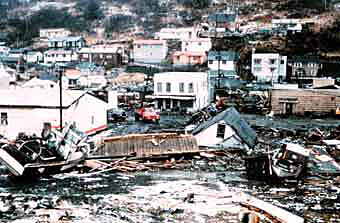Earthquakes Primer

About 8,000 mini-quakes a day, and on average, one exceptionally big one per year
by Borgna Brunner |
 Earthquakes in residential areas, such as this 1964 one in Seward, Alaska, can cause unparalleled damage to life and property. Related Links
|
There are thousands upon thousands of earthquakes annually, ranging on average from 18 major quakes to more than 2 million very minor ones per year (approximately 8,000 per day). On average, we can expect one exceptionally big one (with a magnitude of 8 or higher) each year.
Earthquakes are caused by forces deep within Earth's interior that continuously affect its surface. When the energy from these forces is released suddenly—usually by shearing movements along faults in the Earth's crust—an earthquake results. See also plate tectonics.
Not "On the Richter Scale"
Although "on the Richter Scale" is still a commonly used expression, the scale, developed by Charles F. Richter of California Institute of Technology in 1935, is no longer the most commonly used magnitude measurement. One of its flaws is its imprecision in measuring the biggest earthquakes, those in the range of 8 or 9.
Different methods of measuring magnitude have superseded the Richter Scale, including surface-wave magnitude, which measures the seismic waves crackling around Earth's surface, and moment magnitude, the newest method, which is based on the size of the fault on which an earthquake occurs and the amount the Earth slips. Moment magnitude is the most uniformly applicable scale.
Intensity versus Magnitude
These two terms are often confused: intensity is based on the observed effects of an earthquake on its surroundings, whereas magnitude measures the amount of seismic energy released.
The Modified Mercalli (MM) Intensity Scale measures 12 increasing levels of intensity (each designated by a Roman numeral) from imperceptible shaking to catastrophic destruction. More subjective and less scientific than magnitude, intensity is nevertheless a meaningful way of capturing the terror and destruction of an earthquake. It is the intensity of the 1906 San Francisco earthquake that is remembered, not its magnitude.
The Twentieth Century's Largest Earthquake







